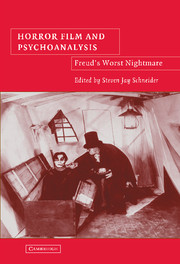Book contents
- Frontmatter
- Contents
- Acknowledgments
- Foreword: “What Lies Beneath?”
- Introduction: “Psychoanalysis in/and/of the Horror Film”
- PART ONE THE QUESTION OF HORROR-PLEASURE
- PART TWO THEORIZING THE UNCANNY
- PART THREE REPRESENTING PSYCHOANALYSIS
- PART FOUR NEW DIRECTIONS
- Afterword: Psychoanalysis and the Horror Film
- About the Contributors
- Bibliography
- Index
Introduction: “Psychoanalysis in/and/of the Horror Film”
Published online by Cambridge University Press: 14 July 2009
- Frontmatter
- Contents
- Acknowledgments
- Foreword: “What Lies Beneath?”
- Introduction: “Psychoanalysis in/and/of the Horror Film”
- PART ONE THE QUESTION OF HORROR-PLEASURE
- PART TWO THEORIZING THE UNCANNY
- PART THREE REPRESENTING PSYCHOANALYSIS
- PART FOUR NEW DIRECTIONS
- Afterword: Psychoanalysis and the Horror Film
- About the Contributors
- Bibliography
- Index
Summary
THE MYTH OF META-THEORY
Over the past thirty years, a plethora of publications have argued in favor of a specific psychoanalytic approach to some dimension or convention of cinematic horror. Included among these are articles and books by such influential scholars as Robin Wood, Carol Clover, Stephen Neale, Linda Williams, Barbara Creed, even Noël Carroll in an earlier incarnation. These efforts have typically taken the form of either interpretive analysis (of a particular film, subgenre, or the genre as a whole) or depth-psychological explanation (of the symbolic/mythic import of horror film monsters; of the horror affect and how it is generated; of the possibly perverse pleasures viewers obtain from being frightened by visible fictions). And despite the often vitriolic criticisms of psychoanalysis both inside and outside academic film studies, the horror genre has continued to see a steady stream of new psychoanalytic approaches, as well as new variations on existing ones.
As originally conceived, the present volume was to be a collection of “meta-theoretical” essays on psychoanalysis and the horror film – not essays that simply (or not so simply, as the case may be) make use of Freudian, Jungian, Kleinian, Jonesian, or Lacanian principles, theses, arguments, or purported discoveries in an effort at shedding light on aspects of the horror film. Instead, it was envisaged that contributors would take a step back to address the relative strengths and weaknesses of such approaches.
- Type
- Chapter
- Information
- Horror Film and PsychoanalysisFreud's Worst Nightmare, pp. 1 - 14Publisher: Cambridge University PressPrint publication year: 2004

